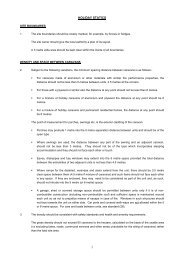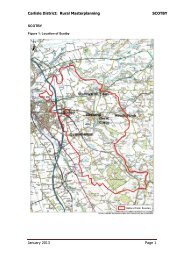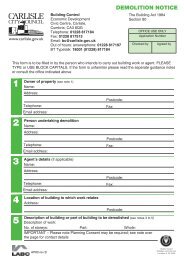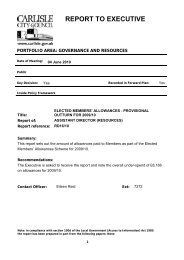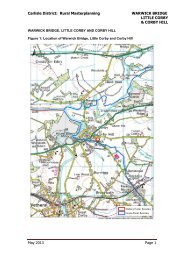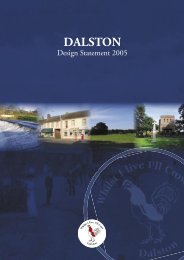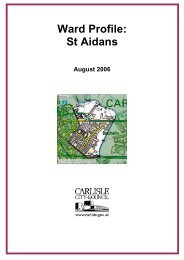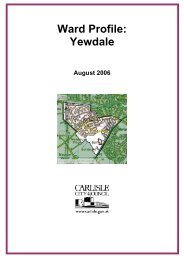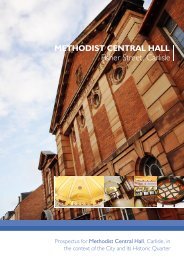Carlisle District Local Plan.indd - Carlisle City Council
Carlisle District Local Plan.indd - Carlisle City Council
Carlisle District Local Plan.indd - Carlisle City Council
You also want an ePaper? Increase the reach of your titles
YUMPU automatically turns print PDFs into web optimized ePapers that Google loves.
<strong>Carlisle</strong> <strong>District</strong> <strong>Local</strong> <strong>Plan</strong> 2001 - 2016 Revised Redeposit draft6.50 The <strong>City</strong> <strong>Council</strong> will encourage proposals for the enhancement of major archaeologicalsites, especially Hadrian’s Wall. Such enhancement works could include repairs to protectarchaeological remains from damage and interpretation of features. A notable example ofsuch interpretation work has been carried out by Cumbria County <strong>Council</strong> at BirdoswaldFort. Where appropriate the <strong>City</strong> <strong>Council</strong> will use planning obligations to promote andenhance major archaeological sites and in addition, it will encourage proposals to bebrought forward for the enhancement of other sites of archaeological and historicalimportance.Potential to strengthen this policy by identifying opportunities for promoting major sitesof archaeological importance as tourist attractions. This would also have positive effectson the local economy.POLICY LE12 Scheduled/ Nationally Important Ancient MonumentsDevelopment will not be permitted where there is an unacceptable impact on scheduledand other nationally important ancient monuments and their settings.Could be enhanced by putting more emphasis on supporting documents that wouldpromote and enhance the scheduled/nationally important ancient monument.6.51 Archaeological remains are finite, irreplaceable and in many cases fragile and vulnerable todamage. They are, however, not all of equal importance and within the <strong>Plan</strong> area the <strong>City</strong><strong>Council</strong> considers that the former walled area of the <strong>City</strong>, Hadrian’s Wall, the vallum andassociated archaeological remains are of international importance. These, together withother monuments of national importance are all worthy of preservation. The Proposals Mapshows all known scheduled and other nationally important monuments to which the Policywill apply. It should be noted that any development affecting a scheduled monument willrequire scheduled monument consent.6.52 Paragraph 8 of PPG 16: Archaeology and <strong>Plan</strong>ning states:‘Where nationally important archaeological remains, whether scheduled or not, and theirsettings, are affected by proposed development there should be a presumption in favour oftheir physical preservation’6.53 The <strong>City</strong> <strong>Council</strong> will make full use of its statutory powers to safeguard these archaeologicalremains and will endeavour to preserve them in situ. In exceptional cases, which canonly be decided on the merits of the individual case, where it is either not feasible or thecircumstances of the case do not justify the preservation of the remains in situ, the <strong>City</strong><strong>Council</strong> will ensure by condition and Section 106 Obligation that the archaeologicalevidence is recorded by prior excavation.6.54 Any new building or development which affects a scheduled monument and would lead tothe destruction of the archaeological remains will not be permitted. In many cases, however,it is usually possible to design schemes to minimise damage by using foundations thatraise ground levels under a proposed new structure or by careful siting of open space andlandscape areas.6.55 In the case of new buildings on the site of earlier structures recently demolished, theerection of minor extensions, or the provision of an access, gardens and service trencheswhich would not cause further damage, applications will be permitted.September 2006 107



